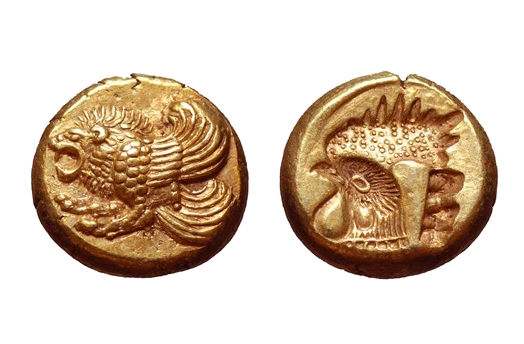
about ancient nomos
Ancient Nomos Art is a museum of galleries exhibiting ancient coins and ancient mint maps. The coin gallery displays the diverse art and history of hand-crafted ancient Greek, Roman, Byzantine, Persian and Medieval coinage. The ancient mints mapping gallery features Greek, Roman, Byzantine, Asia Minor and Medieval mint city regions and territories. Visitor's are welcome to explore, study and enjoy Ancient Nomos Art.

Greek, Lesbos – 521 BC
Mytilene, Lesbos
From Ancient Galleries

Obverse: Forepart of a winged Persian Lion leaping left.
Reverse: Incuse head of Grecian Cockerel (Rooster) facing left.
LEGEND SYMBOLS
Obv: Forepart of a winged Lion leaping (flying) to the left. Rev: Incuse head of Rooster (Cockerel) facing left; small rectangular punch (vertical) behind.
The ancient Greco-Persian island of Lesbos was located in the northeastern Aegean Sea off the coast of Ionia (west Asia Minor). Mytilene, was originally founded in the 11th century BC by the Penthilidae family of Thessaly, who ruled it until the revolt led by Pittacus in 580 BC. The above coin is known as an early archaic electrum coin and has a denomination value called hekte. Electrum is the word used to describe a naturally occurring composite metal comprised of both gold and silver. Mytilene coinage was known throughout Ionia for their beautiful engravings and gem-like artwork. In addition, the exquisite detail of this archaic hekte demonstrates miniature engraving at its absolute finest. It is thought that this coins symbolism and mythology reflects the dual Greek and Persian influences, arising by necessity shortly after the island of Lesbos came under Persian control after the defeat of Croesus by Cyrus in 546 BC. The specific Persian influence is believed to be the origin of the detailed winged lion imagery, while the rooster imagery and motif was of Greek origin. The combination of lion and rooster depictions represented qualities revered by both the ruling Asia Minor Empire and western Greek trade partners. The symbolism was also a sign of strength, perhaps a dual warning of two images intended to frighten those who might present a challenge Lesbos. This coin clearly draws its inspiration from the earliest beginnings of human coinage coming out of Lydia, nearly a full century earlier. As the ancient Celator’s die engraving and gem-cutting knowledge of coin minting technology evolved and advanced, the archaic depictions became more sculptural, offering high-relief and highly detailed designs on the obverse, with an equally exquisite intaglio reverse image. No longer is the archaic reverse design a simple incuse punch found on the earlier Lydian coins. As noted, the coins obverse depicts a winged lion shown leaping to the left while roaring, symbolic of Persian military might, bravery and power. The coins reverse depicts an elaborate incuse rooster image, seen wearing a collar of six pearls. The rooster is famous for crowing at daybreak and was linked in Greek mythology with dawn and morning. The Ancient Greek word for “rooster” is Alectryon. In Greek mythology, the youthful Alectryon was asked by Ares to stand guard outside his door while the god indulged in illicit love with Aphrodite. As Alectryon fell asleep, the sun god Helios walked in on the illicit affair. Ares thus turned Alectryon into a crowing rooster and never again did he forget to announce the arrival of the sun in the morning. In the Christian era, the rooster symbolizes the resurrection and is often seen placed on church spires. This specimen is an important example of the critical evolution of technique, engraving and master craftsmanship, making it possible for Lesbos to couple two distinct mythological motifs onto a single coin. By physically exhibiting the sacred symbols shared by both Persia and Greece, Lesbos was able to cleverly balance political and economic allegiances at a time when the island found herself geographically between two distinct and competing regions. As an interesting side note, the minting authorities charged with this coin continued to feature the archaic incuse rectangle from the earliest Lydian designs, located vertically near the back of the neck of the incuse rooster.
DOCUMENTATION
Value: Hekte. Metal: Electum. Weight: 2.62 grams. Mint: Mytilene, Lesbos. Date: 521-478 BC.
Attribution: Bodenstedt Em. 9.1 (same dies); Sylloge Nummorum Graecorum (SNG) Copenhagen 301; Jameson 1472; SNG von Aulock 1685; BMC 18-25; Boston MFA 1679-81; Gulbenkian 874-5; Pozzi 2315-6; HGC 6, 933; Weber, Plate 200, 5605 (variety).
Legend, Documentation and Attribution
